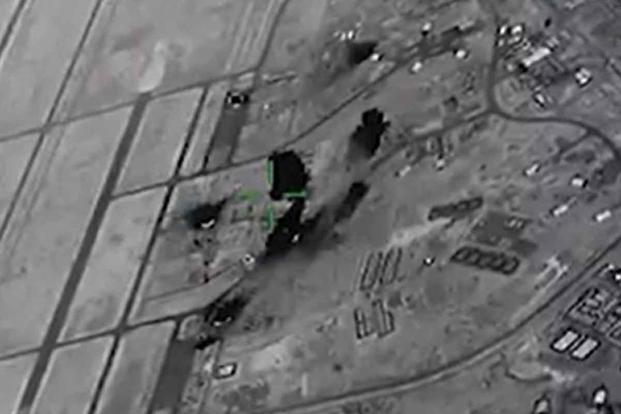Army Maj. Alan Johnson recorded a video message to his son hours before Iran began attacking Al Asad Airbase in Iraq.
"Hey buddy," Johnson said in the emotional video he recorded for his son on Jan. 8, 2020, which 60 Minutes aired Sunday night. "If you're seeing this video, some bad things happened to dad last night, so I need you to be strong, OK? For mom. And just always know in your heart that I love you."
The Defense Department on Monday released newly declassified footage of the ballistic missile strikes on Al Asad last year. The Jan. 8 2020 attack was retaliation for a U.S. drone strike five days earlier that had killed Maj. Gen. Qasem Soleimani, the head of Iran's elite Quds force.
More than a year later, though, tensions remain high between the U.S. and Iran. Last week, President Joe Biden ordered airstrikes in Syria targeting facilities belonging to Iranian-backed militants. The strikes were in response to a February rocket attack in Iraq that killed a civilian contractor and hurt a U.S. service member.
The video the Pentagon released this week shows drone footage of the 2020 attack, which brought the U.S. and Iran danger close to war. The footage shows explosion after explosion erupting at the base.
No American troops died in the attack, but Marine Gen. Kenneth "Frank" McKenzie told 60 Minutes the U.S. had a plan to retaliate if they had been. He estimates the U.S. was close to losing between 100 and 150 personnel and up to 30 aircraft.
Officials at first said no one was injured at Al Asad, but more than 100 troops were later diagnosed with traumatic brain injuries and Purple Hearts were approved for more than two dozen. About 2,000 troops there scrambled into bunkers to take cover after receiving warning that an attack was coming.
The bunkers in which Johnson and others were taking shelter were designed to protect troops against warheads weighing about 60 pounds. Each missile launched by Iran carried a warhead weighing more than 1,000 pounds, according to 60 Minutes.
"The fire was just rolling over the bunkers, you know, like 70 feet in the air," Johnson told CBS, adding he recalled thinking, "'We're going to burn to death.'"
Lt. Col. Staci Coleman, 443rd Air Expeditionary Squadron's commander, described feeling waves from the blast throughout her entire body. She also thought of her family after receiving warning of the attack, Military.com previously reported, texting them "I love you."
Leaders with U.S. Space Command told Military.com last summer that American lives were saved by space operators, who were able to spot the incoming threat and alert those in its path.
"My greatest fears were not realized that day because we did respond very quickly ... in terms of warning to troops that were threatened on the ground," said Air Force Maj. Gen. John Shaw, commander of the Combined Force Space Component. "And I believed [that] saved many lives."
-- Gina Harkins can be reached at gina.harkins@military.com. Follow her on Twitter @ginaaharkins.
Related: 'Emotions and Chaos': Air Force Releases Eyewitness Accounts of Al Asad Missile Attack












